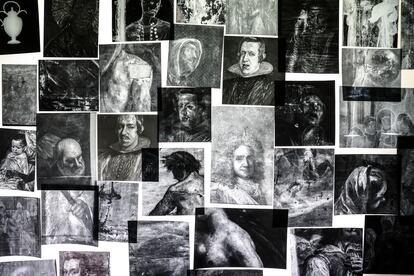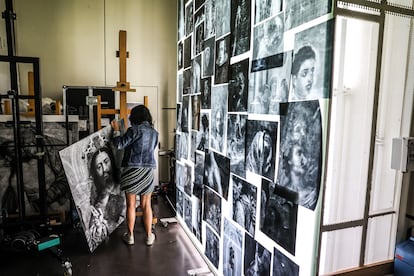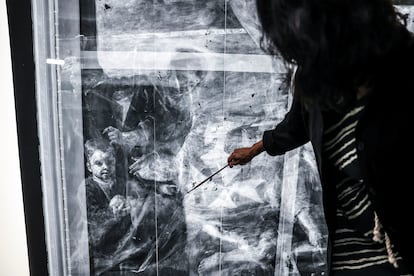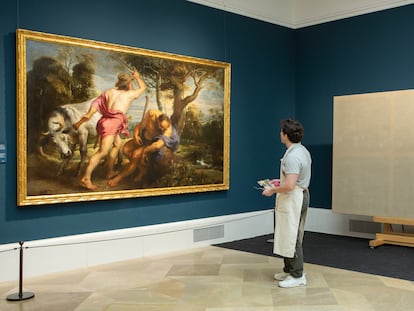How X-rays reveal the secrets of Madrid’s Prado Museum
Radiography and reflectography can penetrate works of art layer by layer, telling us how an artist worked, and uncovering old paintings hidden beneath newer ones

A sign warning of possible radiation exposure welcomes visitors to a little-known corner of Madrid’s Museo del Prado. Located in a restricted area in the museum’s basement, the laboratory is especially designed for working safely with radiation — not the kind of facility one might expect to find in an art museum. Facing the room’s main entrance, a large, upright light table covered with dozens of fragments of radiographic film obscures almost an entire wall. The images are fragments from a multitude of paintings curated by the museum: the face of a king, the support for a sculpture, the detail of a shoulder, or the corner of a canvas frame. In this place, art is X-rayed.
While still a relatively unknown application, the use of X-rays to examine art began shortly after the technique was discovered. Its first use was in medicine. Later, the technology made the leap to anthropology and the study of mummies, and eventually to the analysis of paintings. In the Prado Museum, the first painting to undergo radiographic analysis was Van Der Weyden’s The Descent from the Cross, in the mid-1970s. Half a century later, the use of radiation to unravel a painting or sculpture’s past became part of the institute’s daily routine, not only at this museum, but at other galleries around the world.
Laura Alba Carcelén, a senior technician in the Department of Technical and Laboratory Documentation at the Museo Nacional del Prado, is in charge of the X-ray machine, a tool she considers especially useful for the study of art: “It is a non-invasive test that does not require sampling. The object is not going to be damaged and the whole work can be examined. There is no limit to its application,” she says, speaking to EL PAÍS in the museum’s lab.
Thanks to the imaging technique known as infrared reflectography, researchers have discovered, for example, that in the painting Christ between the Virgin Mary and Staint John the Baptist, by Jan Gossaert, the heads were drawn independently on sheets of paper that were then pasted onto the canvas; moreover, the figures were traced, either from the original work (Ghent Altarpiece, or Adoration of the Mystic Lamb, by Jan and Hubert van Eyck) or from an intermediate reproduction.

X-rays can provide information about every layer of an object, whether it’s a painting or a sculpture: radiography reveals information about the primer layer, the support, the materials used, how they were applied, etc. But like any data, this information must be interpreted. “It requires some training because you see all the information superimposed on the same image, and you have to know how to discern which layer contains which elements. Sometimes it’s very obvious and sometimes it’s a bit more difficult. Things can confuse you and lead to misinterpretations,” says the specialist.
In order to unravel all the secrets hidden in, for example, a large painting, a group of people who specialize in the handling of art must carefully transport the pieces to the lab. Then the work is placed on a wall that allows for the greatest possible distance between it and the machine, to reduce geometric deformation and distortion. Technicians must calculate the amount of film required for the analysis, then cut and assemble the film with its edges overlapping, so as not to lose a single centimeter of the work.
The images are taken in a single shot, and developed plate by plate. In order to analyze the images in detail on a computer and then store them digitally, the radiographic films are scanned, and the negatives are digitized and stored at high resolutions, to complement the physical archive. Digital image processing makes it possible, for example, to isolate portions of an image, such as a face, as in the case of the painting Niños jugando a los dados. Thanks to X-ray analysis, museum technicians were able to discover that another painting was hidden underneath the surface painting: a full portrait of a knight of the Order of Malta. To study such a case in detail, digital imaging also allows the removal of elements that otherwise prevent the perception of others, though great care must be taken to avoid missing information that could be relevant to the investigation.

The images are digitally archived, but they are also stored using a custom physical filing system. To fit the largest X-ray prints, some drawers must be up to three or four meters long. The art world has taken technology designed for other industries and adapted it to its own purposes. Large radiographic films, for example, are often used in aeronautics, to examine welds on airplanes or pipelines. Museums must adapt these materials to their own needs. “Reflectography was developed specifically for its application in the study of painting and art, but one challenge with radiography is that there are no materials specifically designed for us, because X-rays are mostly used for other purposes. We have to study all the materials and equipment that come on the market to see which ones we should buy, either from industrial or medical companies, but usually from industrial suppliers,” Alba explains.
Once all the necessary preparations are made and it’s time to take the X-ray, the lab technician closes the room containing the machine and prepares to enter the parameters so that the image will be captured correctly: the kW of voltage, the mAh of intensity, and the length of exposure are precisely calibrated. These three variables, along with mathematical formulas, are used to obtain a satisfactory result. It is not a simple science, however, and it requires multiple preliminary tests. Alba explains: “In general, you want to see everything, so what you’re looking for are the conditions that allow you to observe the area of highest and lowest absorption, hence the tests. To do a test, you look for an area of maximum and minimum absorption. The current determines the quality of the radiation, the energetic power it has, and the intensity, or the amount of radiation. This is what normally defines the range of grays, the details… The greater the intensity, the more detail and the greater the range of grays you’ll have.” In Niños jugando a los dados you can see that the bottom is much more absorbent than the top. The top one only has one primer layer that absorbs less, and the bottom portion is painted over another painting.
Like any other industrial application of the technology, when working with ionizing radiation, technicians must obtain a radioactive facility supervisor’s license through Spain’s Nuclear Safety Council (CSN), Alba says. In addition, because they are exposed to radiation, workers in these facilities must wear an indirect-reading dosimeter to record radiation levels, and every month must submit the device to a company approved by the CSN for inspection. The Prado lab also has a radiometer that allows for radiation levels to be checked on the spot, and the CSN conducts inspections of the facilities and verifies that workers have passed their medical check-ups.
What kind of academic training is required to work in a place like this, where art history mixes with mathematical formulas? According to Alba, technicians come from all different backgrounds, but in her case, after studying science in high school, she graduated with a degree in Fine Arts, specializing in Restoration. Her colleague with the most expertise in reflectography is an art historian, and according to Alba, the British Museum’s X-ray technician is an archaeologist, and the Louvre’s is a physicist. “The most important thing is not so much taking the image, but interpreting it. Whether a person has a background in science or a background in humanities, they can learn it; the important thing is the experience,” she says.
Sign up for our weekly newsletter to get more English-language news coverage from EL PAÍS USA Edition
Tu suscripción se está usando en otro dispositivo
¿Quieres añadir otro usuario a tu suscripción?
Si continúas leyendo en este dispositivo, no se podrá leer en el otro.
FlechaTu suscripción se está usando en otro dispositivo y solo puedes acceder a EL PAÍS desde un dispositivo a la vez.
Si quieres compartir tu cuenta, cambia tu suscripción a la modalidad Premium, así podrás añadir otro usuario. Cada uno accederá con su propia cuenta de email, lo que os permitirá personalizar vuestra experiencia en EL PAÍS.
¿Tienes una suscripción de empresa? Accede aquí para contratar más cuentas.
En el caso de no saber quién está usando tu cuenta, te recomendamos cambiar tu contraseña aquí.
Si decides continuar compartiendo tu cuenta, este mensaje se mostrará en tu dispositivo y en el de la otra persona que está usando tu cuenta de forma indefinida, afectando a tu experiencia de lectura. Puedes consultar aquí los términos y condiciones de la suscripción digital.
More information
Archived In
Últimas noticias
Most viewed
- Reinhard Genzel, Nobel laureate in physics: ‘One-minute videos will never give you the truth’
- Oona Chaplin: ‘I told James Cameron that I was living in a treehouse and starting a permaculture project with a friend’
- Pablo Escobar’s hippos: A serious environmental problem, 40 years on
- Why we lost the habit of sleeping in two segments and how that changed our sense of time
- The fall of a prolific science journal exposes the billion-dollar profits of scientific publishing











































